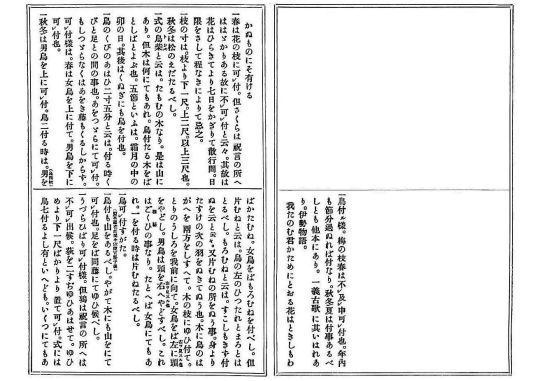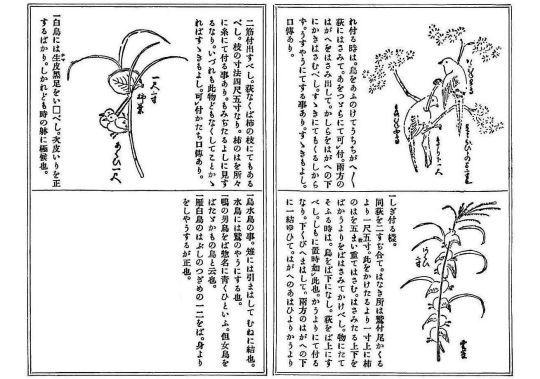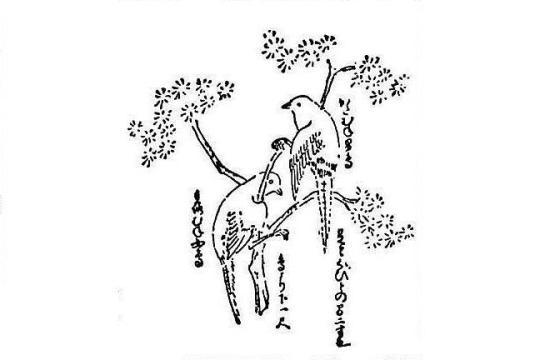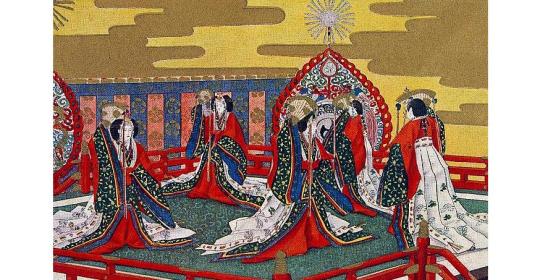#but in the middle of being like 'why would u say fabric flower is aru sekai related' this hit me
Explore tagged Tumblr posts
Text
i am so fucking stupid i cannot believe it took me this long to realize it. there's a space in the jpn title of laboratory so the title matches the same repeating kana theme that marshall maximizer and unplanned apoptosis have.
#aru sekai series#THATS SO SIMPLE HOW DID I MISS THAT OF ALL THINGS#im tryinf to find jpn speakers who like the series to follow#bc i want friends#but in the middle of being like 'why would u say fabric flower is aru sekai related' this hit me
2 notes
·
View notes
Text
Nampō Roku, Book 4 (19b.1): Appendix II, Part 1 -- Selections from the Gunsho Ruijū (Vol. 19) [羣書類、第19輯].

❖ Selections from the Gunsho Ruijū (Part 19) [羣書類、第19輯]¹.


○ With respect to the way to attach the bird, it is not appropriate to use a branch from a plum tree during the springtime. However, throughout the year, so long as setsu-bun [節分]² has not yet passed, [a bird] can be attached [to a plum branch].
Elsewhere³, it is said that in the Autumn, Winter, and Summer, one should attach [the bird to a plum branch]. One such consideration is based on an old poem. In the Ise monogatari [伊勢物語],
waga tanomu kimi ga tame ni to oru-hana ha toki-shi mo wakanu mono ni zo ari-keru
[我たのむ君かためにとおる花は ときしもわかぬものにそ有ける]⁴.
○ In spring, a flowering branch should be used. However, with regard to sending [a branch of] cherry blossoms to a place where an auspicious celebration is taking place: because there is something that gives one pause, it is best not to do so -- so it has been said⁵.
The reason for this is because, once this flower opens, just seven days will pass until [the petals] scatter. Since that date is fixed, and because we cannot estimate it⁶, this makes [sending a flowering branch of cherry blossoms] something to which we should be averse.
○ With respect to the dimensions of the branch, the lower part [below the bird] should be 1-shaku; that above should be 2-shaku. The above [added together] are 3-shaku⁷.
In Autumn and Winter, it is better if a branch from a pine tree can be used.
○ When speaking about the rule⁸ for the to-shiba, [the branch used] should [suggest] a tree in which [the bird] sleeps⁹. This should be [a tree] in the mountains -- but the tree can be of any kind¹⁰.
A [branch of a] tree to which a bird has been attached is called a to-shiba [と��ば]¹¹.
Speaking of the Gosechi¹², [this ceremony is held] in the Eleventh Month, on the middle day of the rabbit¹³. After that date the bird may also be attached to [a branch of] the kunugi [くぬぎ] oak¹⁴.
○ If we say that the length of a bird's neck is 2-sun 5-bu¹⁵, then this should also be the distance between the neck and the legs [of successive birds¹⁶] when they are attached [to the branch].
[The bird] should be attached with a length of ao-tsuzura [青葛藤]¹⁷. But if tsuzura is not available, then there will be no objection to using green wisteria vine¹⁸.
Regarding the way [the birds] should be attached, in Spring, the female bird should be above, while the male bird should be attached below.
○ In Autumn and Winter, the male bird should be attached above¹⁹.
When two birds are being attached, if it is a male, it should be [oriented] “katamune” [かたむね]²⁰; while if it is the female bird, the “moromune” [もろむね]²¹ [orientation] should be used when attaching it [to the branch].
However, when we say “katamune,” [we mean that] the left side of the bird’s chest should be held so that it rests [against the branch]²². When we say “moromune,” [this means] that neither [side of the breast] should be pressed tightly [against the branch]²³ -- so it has been explained. Again, at the place where [the bird is oriented] katamune, it is secured in place with thread: the body is supported by the attached wing [on that side], which is pierced and sewn through²⁴. The bird’s wing is attached to the tree on both ends [near the shoulder and near the wing-tip]: it is tied onto the branch.
The female bird’s head is carried on the left²⁵, while the male bird’s head should be carried on the right²⁶. This [teaching] is absolutely secret²⁷.
[Nevertheless] there is a case where the female bird may also be [arranged] like [a male]: if you only [attach] one [bird], it should [always] be katamune.
○ This [sketch] shows the way the bird should be attached²⁸.

[The writing reads (from right to left): katamune ondori (かたむね男鳥)²⁹; ashi to kubi to no ma ni-sun nari (足と首との間二寸也)³⁰; tori yori shita isshaku (鳥より下一尺)³¹; moromune metori (もろむね女鳥)³².]
__________________________
¹The material translated here is taken from the Gunsho Ruijū (Vol. 19) [羣書類、第19輯], which was originally published in An-ei 8 [安永八年] (1779)*. The series was reissued as a facsimile of the original block-printed editions of the documents between 1898 and 1902. Authorship of the passages included here is credited to Shijō Takashige [四條隆重; 1507 ~ 1539]† in the original version, with the manuscript on which the printed edition was based‡ having been dated “the middle of the Ninth Month of Tenmon 4” (Tenmon yon-nen kiku-zuki chū-ku [天文四年菊月中句]**), 1535.
In this translation I will remain faithful to the original division of the material into sections -- even though, occasionally, it might seem more natural to group things differently in English.
In the specimen of the block printed pages from which this translation was made, I decided to redact the preceding passages (which dealt with the way to prepare the several varieties of birds that were commonly taken with hawks for eating††), as well as the editor’s publication notes and specifications, which immediately followed the final entry, since this information was completely irrelevant to the discussion we are undertaking here. ___________ *This was an encyclopedic compendium of all of the known manuscripts, dealing with all cultural matters, that had been identified from ancient times. The block-printed edition of the Kundai Kan Sa-u Chō Ki [君臺觀左右帳記], and one of the versions of the O-kazari Ki [御飾記], were included in this source.
†Takashige was a court noble, whose house was directly descended from the northern branch of the Fujiwara family.
Their family name derives from the location of their mansion, at Shijō ・ Ōmiya [四条・大宮], in Kyōto.
‡According to a note that accompanies the ascription, the editor indicates that the text was based on a copy of Takashige's original manuscript that was dated the year that he died. Unfortunately, historical records indicate that Shijō Takashige actually died several years later.
**Tenmon yon-nen kiku-zuki chū-ku [天文四年菊月中句]: kiku-zuki chū-ku [菊月中句] literally means “in the middle part of the Month of Chrysanthemums.” “Month of Chrysanthemums” is the classical name for the Ninth Lunar Month.
††Several particularly unsavory culinary preparations -- such as when the raw skin of a wild goose is intended as a side-dish, “it should be soaked briefly in sake,to draw out the ‘black blood,’ which should then be discarded” -- are described in more detail than one might consider strictly necessary.
Unfortunately -- or, perhaps, fortuitously -- those passages in the original manuscript were riddled with missing words, rendering Takashige’s unappealing prose even more obscure.
²Setsu-bun [節分].
Setsu-bun [節分], which occurs on February 3 or 4 each year, marks the beginning of Spring. Since it is calculated according to the solar cycle, the date does not vary (any more than the equinoctes or solstices vary from year to year) the way the months do in the Lunar calendar. Sometimes setsu-bun occurs after the Lunar New Year (as was the case this year), and in some years, it is before.
The passage is saying that a plum branch can be used for the to-shiba [鳥柴] between the end of Spring (rikka [立夏], the first day of summer, occurs on May 5 or 6) and the setsu-bun of the following year. During this time, the branch will not have any flowers (or the withered remains of flowers): from autumn there will be buds, but before setsu-bun they will still be small, and not showing color. (Of course the argument does not take into consideration the fact that global warming has advanced the season, so that the ume occasionally begins to bloom as early as December now.)
³Aki fuyu natsu wa tsuke-koto aru-beshi tomo ta-hon ni ari [秋冬夏は付事あるべしとも他本にあり].
Ta-hon ni [他本に], which I have translated “elsewhere,” literally means “in books [written by] others.” The author of this material does not cite any external sources for this version of the argument.
⁴This is the same poem, a fragment of which was quoted by Yoshida Kenkō, in his entry devoted to an explanation of the to-shiba.
As translated there (under footnote 17 of the previous post, which was Appendix I), the poem reads:
“I entrust them [to you] -- since it was [just] for you [that I made] these folded flowers
“which do not know the season [to bloom] -- these things are like that.”
This precedent is apparently interpreted to mean that plum blossoms should be used when they are not flowering: when fabricating a branch of artificial blossoms, an actual branch of the appropriate species was used in the interests of realism. (People of those times were more intimately familiar with the trees and plants that populated their environments than we are today.)
Citing this quotation makes it clear that Shijō Takashige was familiar with Yoshida Kenkō’s writings.
⁵Tadashi sakura wa shūgen no tokoro e wa habakari aru yue ni fuka-tsuki to iu-iu [但さくらは祝言の所へははゞかりある故に不可付と云々].
Shūgen no tokoro [祝言の所]: shūgen [祝言] means festivities or celebrations of a happy or auspicious nature -- today the word is usually used to refer to a wedding; tokoro [所] means the place (where such festivities are being held).
Habakari [はゞかり = はばかり] means hesitation, hindrance.
As the saying goes, cherries are loved not only on account of their beauty, but because they flower so briefly. This brief flowering, and the fact that the petals scatter from the fully open blossoms (without withering, as most flowers do) would not auger for an auspicious and long life (indeed, it suggests a life that is cut short in its prime*), and this is why one would feel a certain hesitation about sending a to-shiba to a place where such celebrations were taking place. ___________ *And that is the sense with which cherry blossoms are sometimes used in poetry.
⁶Sashite-hodo naki ni [指して程なきに].
Sashite-hodo [指して程]: sasu [指す] means to point, designate, indicate; hodo [程] means about, approximately.
But here we have no ability (naki ni [無きに]) to conjecture the approximate date (when the cherry blossoms will fall), since we do not know when they opened*. Thus, if one happens to come across a cherry in bloom, while it will be beautiful, and tempt the huntsman to use it for his to-shiba, he should not do so if the place to which he will send the to-shiba is celebrating a happy occasion† -- since the falling petals will bode ill for a long and prosperous future. __________ *The branch to which the bird or birds are attached is supposed to be collected from the area of the hunt, and the hunting party (which was mounted on horseback, so they could follow the hawks pursuit of the game that had been flushed) would likely have arrived there purely by chance.
†This is the point. A branch of cherry blossoms may be used -- and likely would be appreciated (even if some of the petals are scattering), perhaps even moving -- under ordinary circumstances. It is only when the to-shiba will arrive during a celebration that one needs to be circumspect.
⁷Ijō san-shaku nari [以上三尺也].
Ijō [以上] refers to the previous phrases, not to the length of the upper part of the branch.
⁸Shiki [式の].
Shiki [式], in this case, refers to the formula or plan dictating the correct way to do something. The construction that will result in the image or impression that one is supposed to create.
⁹Tamomu-no-ki nari [たもむの木なり].
Tamomu [眠む] means to sleep. Tamomu-no-ki [眠むの木], then, refers to a “sleeping tree” -- not a tree that is sleeping, but a tree in which the birds sleep.
This is why the bird should arranged so that it appears to be squatting on a branch, since that is the normal way for birds to sleep.
¹⁰Kore ha yama ni ari, tadashi ki ha nani ni te mo are [是は山にあり、但木は何にてもあれ].
The tree should be of a kind that is found in the mountains. However, the kind of tree is not specified -- one makes use of whatever is available, since the idea is to give the recipient an idea of where the prey was taken.
¹¹To-shiba to yobu nari [としばとよぶ也].
Here the intent appears to be to indicate the correct pronunciation. It is “to-shiba” [としば = 鳥柴], not “tori-shiba” [鳥柴] (as might seem to be the correct reading, based on the kanji).
¹²Gosechi [五節].
This refers to an ancient court ritual involving dances performed by groups of young women who were selected from among the daughters of the lower echelon of court nobles (their rank is shown in the drawing by the long, white trains that were attached in back to cover the hems of their robes). The dances were originally part of the Shintō Harvest Festival.

The Gosechi-no-mai [五節の舞] seems to have been lost during the medieval period*, which may be why Shijō Takashige felt the need to state the date (since it was apparently based on this date that the use of the kunugi [櫟] as the branch for the to-shiba was sanctioned -- just as the arrival of setsu-bun dictated the beginning of the period when a branch from a plum tree could not be used). __________ *During the centuries when the different military families were vying for control of the country, the Imperial Court was often denied the funds needed to stage ceremonies such as this; and when such a state of affairs had continued for a number of years, the details began to be lost.
¹³Shimo-tsuki no naka no u-no-hi [霜月の中の卯の日].
This appears to be the date of the Gosechi dances.
Shimo-tsuki [霜月], the “Month of Frosts,” is the classical name for the Eleventh Month of the Lunar year.
U-no-hi [卯の日] is the “Day-of-the-Rabbit”: the 12 animals of the Chinese zodiac were used to designate the sequence of days in a repeating cycle*, and the Day-of-the-Rabbit was the fourth day in the cycle.
The Gosechi dances (according to this source) seem to have been performed on the middle* (or second) Day-of-the-Rabbit† that occurred during the Eleventh Month. __________ *Since the cycle is twelve days, while each month has 29 or 30 days, each of the animal-names occurs two or three times each month. While the series remains the same -- rat, ox, tiger, rabbit, dragon, snake, horse, sheep, monkey, rooster, dog, and pig -- the animal corresponding to the each day of each month differed from year to year.
†The term naka no u-no-hi [中の卯の日] means that the u-no-hi [卯の日] (Day-of-the-Rabbit) occurred three times during the month. This would have been the second occurrence of the day.
There was another rule that decreed the date of the dances when the Day-of-the-Rabbit occurred only twice during the Eleventh Month -- but Takashige has not included it in his comments.
¹⁴Kunugi [くぬぎ].
Kunugi [櫟] is an Asian species of oak (Quercus acutissima)*, referred to as the sawtooth oak in English. The acorns of this oak can be used for food.
This kind of oak was used for fuel†, which may be the symbolic reason why it could be used from this time‡. __________ *This oak makes up a considerable proportion of the brushwood species that populate the understory of Japanese forests on Honshū.
The timing is probably related to the fact that after the middle of the Eleventh Month, the wood would have dried out sufficiently to be used as fuel.
†Oak charcoal was made from this tree. This kind of hardwood charcoal was used in iron production, and requires a forced air flow to burn at its hottest. (It cannot be used in the furo or ro, for example. The charcoal used in chanoyu is softwood charcoal, originally made from pine.)
‡Since, from this time, the winter will be deepening.
¹⁵Tori-no-kubi no ahahi ni-sun go-bu to iu ha [鳥のくびのあはひ二寸五分と云は].
Ahahi [間] means the interval, in other words, the length from the base of the skull to the shoulder.
To iu ha [と云は]: the present phrase is a supposition. Birds necks are naturally of various lengths.
¹⁶It would appear that the ideas about the number of birds that could be attached to a single to-shiba had evolved in the 300 years since Yoshida Kenkō [吉田兼好, 1284 ~ 1350] recorded the story of Shimotsukeno Takekatsu's explanation of the precedents to Konoe Iehira [近衛家平; 1282 ~ 1324].
Yoshida Kenkō was, of course, a slightly younger contemporary of the Okamoto kampaku (the text of the Tsurezure-gusa [徒然草] was written between 1330 and 1332).
¹⁷Ao-tsuzura [青葛藤].
This is a kind of liana, Cocculus orbiculatus*, related to the kuzu [葛] (arrowroot vine)†, which bears small clusters of blue to black drupes in the autumn. __________ *Or possibly C. trilobus. There seems to be no clear distinction between these two names in the literature (they may be botanical synonyms, but this, too is uncertain); while the range of C. orbiculatus appears to be much farther south (Java) than even the most southern of the Japanese islands.
Sometimes members of this genus (which is extremely widespread, with species being found in Africa, Asia, and North America) are referred to as coralberry or moonseed in English.
†Mentions of “kudzu vines” being used for the purpose of tying, in English translations, are probably references to this vine.
¹⁸Aoi-fuji [あをき藤].
This means the wisteria vine during the growing season. Once the vine has turned brown and hardened, it will be too stiff to use for the present purpose.
Ao-tsuzura, on the other hand, is about half the thickness of wisteria vine, and remains reasonably pliable even in winter, when the vine is mature.
¹⁹This statement seems to have migrated away from the one that precedes it.
²⁰Katamune [かたむね].
Katamune [片胸] means one side of the bird's breast -- in other words, (only) one side is positioned so that it adjoins the branch.
²¹Moromune [もろむね].
Moromune [諸胸]* means “both sides” of the breast -- that is, the the bird's breast-bone is oriented toward the branch, so that both sides of the breast come into contact with the branch slightly. __________ *Moromune [諸胸] literally means that “all” of the bird's breast is oriented toward the branch.
²²Tori no hidari-no-hittare tomaru to ha toru-beshi [鳥の左のひつたれとまるとはとるべし].
Hittare [ひったれ] means the flesh of a bird's breast*. Hidari-no-hittare [左のひったれ] would mean the bird’s left breast, the flesh to the left of the sternum. __________ *Specifically, the flesh that can be eaten.
Anatomically, it appears to correspond to mune [胸] (which means the chest), at least as the words are being used here.
Both the hitatare and the momo [腿], thigh, were used as meat. The rest of the carcass was generally boiled to make soup.
²³Sukoshi mo kizu tsukenu [すこしもきず付ぬ].
Sukoshi mo [少しも] means (in this case*) not at all.
Kizu [着ず] means not cling to, not adhere to; and tsukenu [付けぬ] means not be attached.
The sternum faces toward the branch, but it is not tightly pressed to it (the bird is secured by the neck and by the legs, and sometimes by one of the wings). __________ *Because we are dealing with a negative.
²⁴Mata katamune no tokoro wo nū-koto, mi yori tasuke no tsugi-no-hane wo nukite nū nari [又片むねの所をぬう事、身よりたすけの次の羽をぬ��てぬう也].
Nū-koto [縫う事], and nū [縫う], mean to sew or stitch together.
Tsugi-no-hane [次の羽] means the wing next to (the side of the bird's body facing the branch).
Nuku [貫く] means to pierce, penetrate.
The left side of the bird is held to the branch by a piece of thread sewn through the wing, and then tied to the branch.
²⁵Metori wo ba hidari ni atama wo yadoshi [女鳥をば左に頭をやどし].
Yadosu [宿す] means to hold or carry.
The editor of the block-printed edition has included a gloss beside this line: migi wo mi-suru nari [右を見するなり], which means “it looks to the right.”
²⁶Ondori ha atama wo migi he yadosu-beshi [男鳥は頭を右へやどすべし].
The editor of the published version added the comment: hidari wo mi-suru nari [左を見するなり], which means “it is looking toward the left.”
²⁷Goku-hi [極秘].
Literally, “the most extreme secret.” Top secret.
²⁸In the block printed edition, this sketch was printed elsewhere, with only a gloss to indicate that it should be found here. I have restored it to what is assumed to have been its original place in Shijō Takashige’s manuscript.
²⁹Katamune ondori [かたむね男鳥]: the male bird (is oriented) as katamune. The bird represents something like a pheasant (kiji [雉 -- though “雉子” is preferred today]).
³⁰Ashi to kubi to no ma ni-sun nari [足と首との間二寸也]: the distance from the legs (of the upper bird) to the neck (of the lower bird) is 2-sun.
³¹Tori yori shita isshaku [鳥より下一尺]: below the (lower) bird, (the branch extends) 1-shaku (further).
³²Moromune me-tori [もろむね女鳥]: the female bird (is oriented) with the whole of its breast (toward the branch).
1 note
·
View note